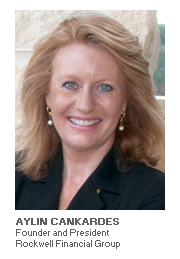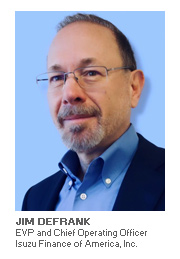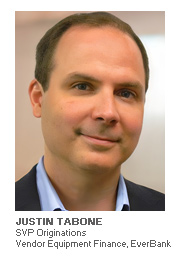
The Equipment Leasing & Finance Foundation (Foundation) released its Q4 update to the 2023 Equipment Leasing & Finance U.S. Economic Outlook in mid-October. According to the most recent report, equipment and software investment expanded at a 5.3% annualized rate in Q2 after contracting in Q1. Early indications suggest that investment may have weakened in Q3, however, as credit availability continues to tighten. According to the report, many businesses have adjusted expansion plans in anticipation of slower economic growth later this year. As a result, the Foundation’s investment growth forecasts are modest for both Q3 (1.2 percent annualized) and Q4 (0.5 percent annualized).
Equipment Finance Advisor engaged in discussions with three industry leaders in mid-October, each of whom embodies a distinct sector within the equipment finance industry. These conversations aimed to uncover their perspectives on the latest industry report and shed light on the projected trajectory of the equipment finance sector. Our participants included Justin Tabone, Senior Vice President Originations, Vendor Equipment Finance, with EverBank (Bank-owned); Aylin Cankardes, President of Rockwell Financial Group (Independent); and Jim DeFrank, Executive Vice President and Chief Operating Officer at Isuzu Finance of America (Captive).
We began our discussion by asking each participant to describe their view of the current economic environment, and if they agree with the Foundation that businesses have adjusted their expansion plans.

“The Foundation’s findings are on target regarding demand for equipment holding up despite rising interest rates and the headwinds faced in the economy this year,” said Aylin Cankardes. “Equipment and software investment growing at 5.3% annualized in Q2 after contracting in Q1 is a positive signal. Despite significant challenges, the labor market is showing resiliency and inflation appears to be heading towards a soft landing. With the rapid rise of rates in a short amount of time there is considerable uncertainty still present in the market, but we continue to see innovation and flexibility from our customers as they adapt to the shifting landscape. As can be expected, businesses are taking a great deal into consideration regarding their capital expenditure requirements and their greatest concern is getting in front of a possible recession. Some companies have adjusted their expansion and acquisition plans by delaying orders while others have continued to stay the course on their capital procurement goals.”
She continued saying, “Outside of prolonged delivery times for new manufacturing and industrial equipment orders, we are seeing positive trends in supply chain timelines as businesses continue to invest in growth through productive assets.”

Jim DeFrank said, “The current economic environment is dubious at best. There are so many variables it is obviously difficult to predict. The overall labor market along with slower housing starts is very concerning. However, warehouse manufacturing is up which will temper the effects of the slower housing starts. On top of that, add the commercial office real estate vacancy rates and there is a potential hard landing in our future. Of course, the “wild card” is the political uncertainties globally and in the US.”
DeFrank continued, “I do agree that some businesses have slowed their expansion plans. The simple fact that the cost of equipment and interest rates have almost doubled in the last five years makes expansion an expensive proposition. It also requires these businesses to restructure their pricing to their customers as they need to pass on these increased costs of doing business. This is attributing to the stickiness of inflation. There is still pent-up demand to replace older equipment while manufacturers are trying to catch up with orders. This is one factor that is driving finance and leasing volumes through Q4 2023 and into the first half of 2024.”

Justin Tabone said, “The Foundation outlook underscores the need to be vigilant and responsive to changing conditions. We are considering headwinds such as higher rates, increasing costs and changing economic conditions. Vendors that know how to effectively position financing in their sales process are most likely to remain strong and be better positioned to weather economic challenges. They are still adjusting to the new rate environment, so lessors that provide creative offerings and/or leverage vendor subsidies to offset higher rates may see more volume than others. Currently, we are benefiting from pent-up demand and an easing of supply chain issues that is driving equipment sales and helping manufacturers succeed despite uncertain market conditions.”
Tabone continued saying, “Industry leaders will be focusing on delivering more efficiency through innovative technology but must also provide human support. Building and maintaining customer relationships will always be at the heart of what we do. Companies losing sight of this will fall behind.”
Credit Standards
According to the report, business lending standards tightened further in Q2 for Commercial and Industrial (“C&I”) loans in Q2. For loans to large and middle-market firms, a net 51 percent of banks reported tightening standards, while a net 49 percent reported tighter standards for loans to smaller firms.
We asked our participants if credit standards within their respective companies and among their competitors tightened over the past 6 months and if captive, independent and even bank-owned equipment finance providers are benefiting in any way from this tightening among banks.
“We are continuously reviewing our credit underwriting standards to ensure that risk mitigation is appropriate,” said Tabone. “In business sectors where market conditions have resulted in heightened levels of risk, we adjust our risk assessment criteria to stay within our tolerance thresholds with the goal of still fully supporting our vendors. As certain banks pull back due to capital issues, it should provide new opportunities for those lenders that are well capitalized and have established relationships with strong vendors to fill some of the void.”
DeFrank responded, “Certain segments we lend to have seen a slight tightening but overall, we are still optimistic of vocational commercial vehicle business for the near future. We have certainly benefited from the tightened lending standards at banks. The smaller businesses are having trouble obtaining the working capital they need and are now looking to equipment finance and leasing companies as well as the OEM’s captive finance companies to take care of their equipment purchases and leave the bank lines open for “brick and mortar” and working capital as well as other needs – something we have all preached to equipment buyers for decades.”
Cankardes said, “Interest rates have been driving the main economic dialogue on most fronts. As the horizon continues to be cloudy and Fed policy has remained at a restrictive level, business lending standards have clearly tightened. Our company’s focus is primarily on the investment grade customer sector, so the rate increases have been reasonably well absorbed and not been as disruptive as we had expected. Our consensus is that the regional bank challenges have generated good debate and discipline for all segments of the finance industry. There is a significant term premium being built in by lenders across the credit range with a strong focus on normalizing profit margins for longer-term deals.”
Cankardes continued saying, “Economic growth, even faced with the headwinds experienced this year, has been quite durable. The final yards on the quantitative easing may be the hardest as lenders continue to tread cautiously in this volatile market to reassess their portfolio exposure.”
Equipment Finance Demand
We asked our participants to comment on what they expect to see in terms of demand for leases and loans – a slowdown, increased or flat overall demand. We also asked them to provide insights into sectors where they anticipate seeing the greatest growth opportunities or declines.
DeFrank replied, “For our business we still see pent up demand as body manufacturers cannot keep up with chassis production. Parts supplies have improved greatly but are still not at normal production levels. We are looking at flat demand as most of these chassis are already sold awaiting body upfits. We do expect to see continued growth in leasing products as the equipment cost and interest rates have driven some loan payments too high for most customers. We have also seen more interest TRAC leases and FMV leases the past two quarters and expect this to continue through 2024.”
He continued saying, “The “final mile” is still going strong for commercial vehicles and with EV being mandated we will see an increase in infrastructure spending and all that goes with it. That being said, internal combustion engines will start to decline in the future and over the next few years EVs, mandated or not, will grow in popularity as long as the infrastructure can keep pace.”
“Many economic experts report that the U.S. economy will avoid a recession and such news should help stimulate purchasing activity, said Tabone. “At the same time, interest rates will continue to be high, which could be a hindrance to financing. Financing partnerships have the potential to expand more so for those lessors that can respond efficiently to the demand for traditional leases and loans while also preparing to offer more creative solutions. Furthermore, financing models that help vendors gain new opportunities and repeat business will continue to gain traction. We know our customers appreciate collaboration, creativity and transparency regarding pricing and terms throughout their equipment finance journey.”
He also said, “Although we continue to see strong growth activity across all sectors we serve, the construction sector is poised for substantial growth as a result of the infrastructure bill. There will be a significant investment in construction equipment due to the bill, which is allocating significant funding to address America’s aging infrastructure including roads, highways, and bridges.”
“There are profit generating initiatives across various sectors, so we are careful not to be impacted by all the negative narrative,” said Cankardes. “The demand for leases and loans has held steady and we expect the trend to continue through the end of the year. As highlighted in the Foundation’s report, challenges facing transportation assets as well as some slowing in the technology sector is beginning to moderate. We currently see the greatest growth in the renewable and energy efficiency sector where our company has a long track record, and we continue to focus our resources on.”
We concluded our discussion by asking how our participants and their companies utilize the Foundation’s Economic Outlook.
Cankardes offered the following comments: “The Foundation’s Economic Outlook report provides our company valuable overview on the changing economic landscape. The extensive research, data and forecast that goes into the report is presented in a concise and clear format for verticals in our industry along with insights on the current state of the U.S. economy. The ability to see how different asset classes and overall markets are performing on a quarterly basis, in addition to understanding the challenges faced in certain segments of the market provides an invaluable insight which can be applied to our strategic ongoing business decisions.”
Tabone said, “The Foundation is an excellent source of data that we use to help make important decisions about our current business and future strategies. The equipment financing industry is fortunate to have access to a resource like the Foundation’s Economic Outlook and the ability to leverage the detailed data that it provides.”
We thank our participants for their time and invaluable insights!
Readers may access the Q4 Report here.
Readers may also download the Momentum Monitor here.
Readers may also read Parts 1 and 2 of this article series:
Part 1: Equipment Finance Industry Faces Numerous Economic and Market Challenges
Part 2: Equipment Finance Industry Continues to Navigate a Complex Environment